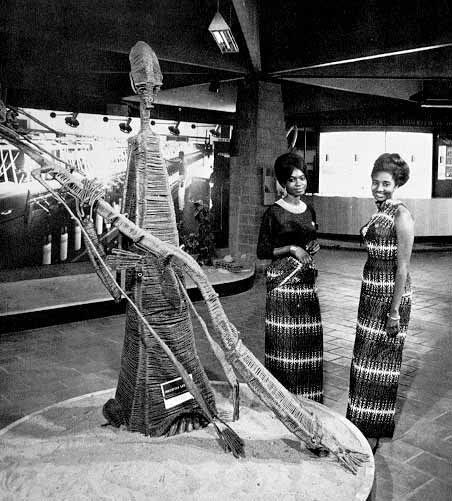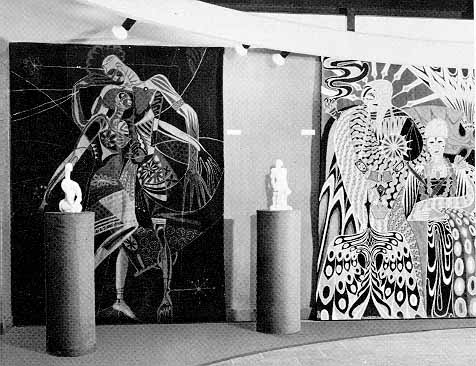African Pavilions
Africa Place was the showcase of 15 African nations that included Cameroun, Chad, Congo, Ivory Coast, Gabon, Ghana, Kenya, Madagascar, Niger, Nigeria, Uganda, Rwanda, Senegal, Tanzania and Togo. Their small red brick pavilions with white and yellow roofs were grouped around a charming esplanade on Ile Notre-Dame.
| Aerial view of Africa Place. |
Cameroun
A plexiglas map showed a colorful, bird's-eye view of a tropical country rich in agricultural resources and forests. Exhibits revealed a wide variety of its products; bananas, peanuts, palm oil, coffee, rubber from its plantations, and rough timber. Cameroun's economy, as the photographs showed, was largely dependent upon agricultural produce. But photos also showed that the country was transforming into an industrial society. A new Trans-Cameroun railway was being developed.The country's rich artistic heritage was on display; fabrics of rich vivid hues, copper masks and lances, musical instruments and fetishes used by Cameroun's ancestors in their ritual ceremonies.
Chad
Inside Chad's pavilion large photographs lined the walls to illustrate its geographical aspects, especially Lake Chad which gave its name to the country. Its people were also represented in their activities with photos; a Buduma fisherman in his long reed boat, a cotton farmer on the savannah, and city dwellers of Fort-Lamy.The pavilion also exhibited a fine selection of original handicrafts; silver trinkets, snake and goatskin articles, ebony carvings, basketwork, mask and spears.
Congo
The pavilion throbbed with the magic beat of music and glowed in the filtered light that played on the frescos which depicted dancers, warriors, oarsmen of the pirigues, and the tropical forest with its wild animals and birds. Two artists were at work nearby; one painting a portrait of a Congolese and the other, a hammersmith, reproducing the face of a chief on a sheet of copper.Masks and statuettes adorned the walls and a large round hall is fitted with shelves and alcoves that provided a setting for magnificent sculptures. There were also displays of 15 pieces of prized wood, textiles, decorative tiles, stuffed reptiles, jewelry, maps and stamps - all part of the country's economy. There were also samples of cobalt, gold silver and copper, since the Congo produced 1/5th of the world's supply of copper.
Gabon
Gabon's pavilion invited the visitor to learn about its country; its economic, artistic, recreation and cultural aspects. It showed its plans to develop its economy; to improve its agricultural production, mineral exploitation, and its educational system.Zithers, drums and tom-toms accompanied a description of daily life in ancient Africa. A collection of highly imaginative sculptures, masks and fetishes revealed the artistic expressions of forest tribes; Fang, Balu, Bakota, and Pangwe.
Ghana
A skillful arrangement of photographs at the pavilion's entrance revealed the country's equatorial climate, its urban centers and villages, and its industrial and agricultural wealth. A host of samples of Ghana's leading industries complemented these photos; shoes, glassware, laminated wood, coffee, palm oil, coconuts, and cocoa. Its chief exports were ivory figurines and jewelry, ornamental objects of tortoiseshell and raffia goods.The fertility ritual established by the Ashanti tribe was provided in the form of fertility statuettes - small wooden dolls that were worn about women's necks during pregnancy to ensure the child was born beautiful and healthy. Many were on display plus a small collection of exquisite bronzes.
Kenya
Kenya's pavilion was dominated by immense photographs of its national parks and game reserves that are roamed by elephants, rhinoceros, leopards, antelopes, zebras and giraffes. Further examples of the country's fauna were presented in the form of stuffed animals, butterfly and shell collections, and an aquarium.Other photographs and exhibits showed Kenya's variety; its coastal area that bears a strong Arab influence, Mt Kenya in its mountainous western area, and its dry and vast plains where Kenya's largest tribes grow corn, wheat, and its four leading exports - coffee tea, sisal and pyrenthrum. And up on the plateaus, the Bantu raised livestock. An exhibit of shields showed each tribes armorial bearings carved in the wood or painted on the leather.
Ivory Coast
Since arts flourished in the Ivory Coast because they were a means for the African Negro to establish contact with the great forces of nature, its pavilion was filled with it; Baoule sculptures, Senoufo masks and Goro statuettes, ivory ornaments and golden jewelry. A weaver demonstrated his skill on the traditional loom. |
Ivory Coast displayed two string figures of Christian Lattier. |
The visitor could study an outline of the country's history and a summary of its political and administrative organization. On display were its important agricultural and mineral products. There were photographs of the country's commercial and industrial resources and a model of the huge port of Abidjan.
Madagascar
Traditional songs welcomed the visitor and a map helped him locate Madagascar. He discovered its geography of eastern plains, its countless lakes and high plateaus stretching away to volcanic peaks. Agricultural samples were on display, especially vanilla since the country supplies 60% of the world's supply. Here too were rare species of wood like ebony, mangrove, rosewood and mahogany. And precious stones; amethysts, agates, tourmalines and cornelians, all displayed in jewelry.An entire corner of the pavilion was devoted to Tananarive, its capital. Photographs revealed its rapidly developing city, its university and airport. Elsewhere were examples of its flora and fauna.
Niger
On the threshold of the pavilion stood a Niger warrior, his face veiled, his tabouka sword at his side and his dagger attached to his wrist. Inside was a fine assortment of weapons and a large photograph of a parade of fearless desert horsemen in their battle array.A map enabled the visitor to get his bearings and trace the river that gave the country its name. Photographs revealed villages, towns and the outstanding beauty of women belonging to various tribes.
The pavilion displayed its artistic talent. Models wore the traditional costumes of the Touaregs, and the camel herdsmen of the desert looked proudly down over a vast display of gold and silver jewelry, gaily colored cushions, hunting weapons, fans, camel saddles, handbags of snake and crocodile skins.
Nigeria
Many facets of Nigerian life were displayed in its pavilion. Photographs and displays illustrated the wide variety of scenery, its agricultural and mineral products, and its progress in education during the previous 25 years.Art displayed dated back almost 2000 years; pottery from the Neck culture, and Magnificent Ife and Benin bronzes. Since Nigeria is home of the Ibo and Yoruba civilizations, they displayed sophisticated wooden statuettes and masks.
Uganda
Uganda's pavilion featured a panorama of its impressive scenery, equatorial vegetation, wild animals, burning heat and sudden storms. Here too, were a selection of traditional weapons for pursuing big game in the forests.A corner of the pavilion was dedicated to handicrafts. Their people had a talent for furniture making, and employing decorative geometric patterns in their basketwork and pottery.
Rwanda
Inside Rwanda's pavilion the visitor learned that the country's population doubled in less than 25 years and that half its population was under 18. There were photographs of the country's natural beauty, its leading industries, and mineral wealth.Stuffed birds, leopard skins, butterflies and moths illustrated the corner of the pavilion devoted to wildlife. And there was a diorama where zebras and gazelles roamed wild. Photos showed the country's mountains and lakes since Rwanda is known as the Switzerland of Africa.
Age old traditions haunted the exhibits of woodcarvings and basket weaving. A map of Africa lay at the center of an enormous radiant sun, locating the country in relation to the rest of the world.
Senegal
Magnificent tapestries, by Papa Ibra Tall, decorated the pavilion with their powerful designs and iridescent hues. Artists and craftsmen had ingeniously adapted their traditional patterns to modern methods. These could be seen in a collection of finely wrought gold jewelry.Past and present came together in one corner of the pavilion. An imposing collection of Neolithic pottery and rare items of antiquity contrasted with the brilliantly colored paintings of expressionists Papa Didi Diop and Bou Diouf. Masks and fetishes evoked the forces of nature and those of men.
 |
Art work by artist Papa Ibra Tall inside the Senegal pavilion. |
Since a "A Land of Sunshine and Dialogue" was the pavilion's theme, illustrations abounded in the form of photographs of the sandy country. Senegal's economy was largely dependent on peanuts, but soap and oil manufacturing were developing.
Tanzania
Since tourism was Tanzania's chief industry, its pavilion at Expo highlighted both its scenic beauty and variety of wildlife. Large photographs, framed by ivory tusks, crocodile skins and various stuffed animals, showed elephants, zebra, giraffes, cheetahs, rhinoceros and lions.In another corner of the pavilion was a display on agriculture where photos showed young people at work on plantations. Here too, were hunting spears, an ebony mask and a coffee pot from Zanzibar.
One showcase in the pavilion was dedicated to the archaeological excavations by De. L.S. Leakey. His discoveries have proved that ancient man has lived on the land now known as Tanzania since time immemorial.
Togo
Togo proudly showed its main urban centers and mining industry in photography. Elsewhere a craftsman worked on a traditional loom and beside him, a wide range of fabrics was exhibited. Togo's agricultural industry was represented with displays of cotton, copra, cassava root and castor-oil beans.Village scenes were depicted in another corner of the pavilion. Hunting and weapons of war were exhibited beside Kabre statuettes, masks, dolls and a wedding chain symbolizing the eternal links between the newly married couple. Also on display were a small mahogany table, finely carved elephant tusks and stools.
 |
View of the African pavilions. Photo by Bill Dutfield. |